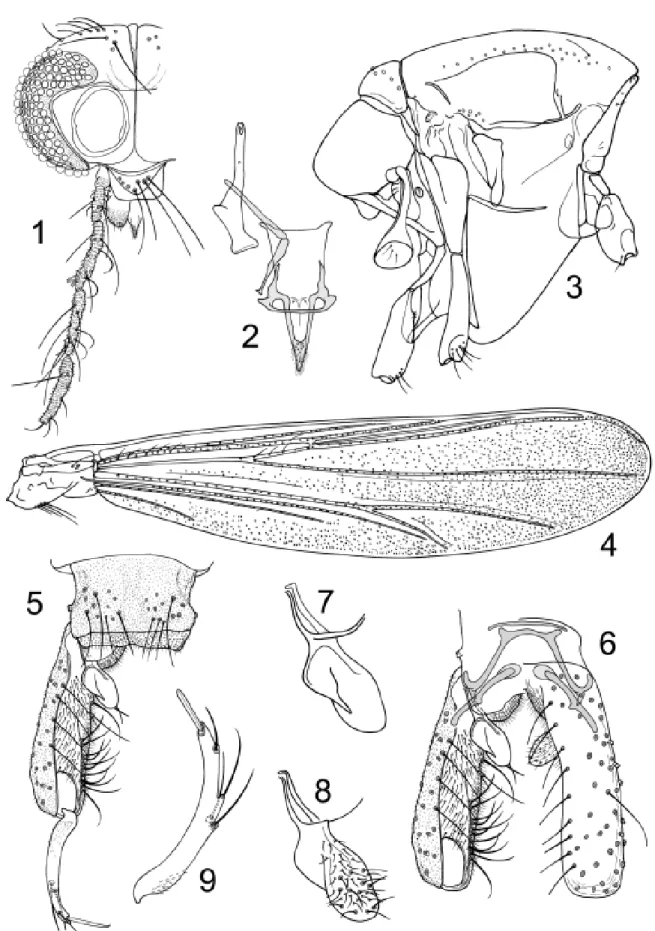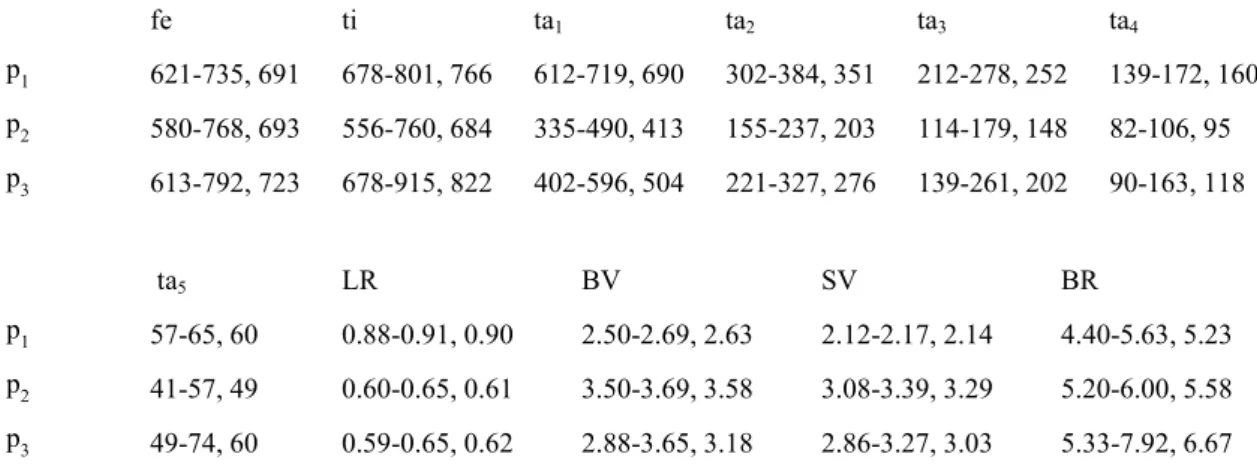CHIRONOMIDAE: ORTHOCLADIINAE) TAKEN IN SOUTH BRAZIL
Museum of Zoology, University of Bergen, Muséplass 3, N-5007 Bergen, Norway 1E-mail: trond.andersen@zmb.uib.no
2E-mail: hfmendes@usp.br
3Corresponding author
Abstract
Irisobrillia longicosta Oliver, originally described from Venezuela, is taken in Malaise traps close to small rivers in the state of Santa Catarina in south Brazil. The specimens from Brazil are small compared to the types from Venezuela, and are thus described in some detail. Irisobrillia is the only genus of the primitive Orthocladiinae close to the genus Brillia Kieffer occurring in the Neotropical region.
Key words: Irisobrillia, Orthocladiinae, Brazil, redescription.
Biota Neotropica v4 (n2) – http://www.biotaneotropica.org.br/v4n2/pt/abstract?article+BN03904022004
Trond Andersen1 & Humberto F. Mendes2,3
Date Received 06/22/2004
Introduction
The genus Irisobrillia was erected by Oliver (1985) based on I. longicosta Oliver, 1985 from Venezuela. Oliver (1985) considered one female from St. Vincent recorded as
Erycnemus sp. by Sæther (1981) as conspecific with the males from Venezuela. Sæther & Wang (1992) described the female from St. Vincent and pointed out that it is consider-ably smaller than the males and that it also apparently lacks setae on squama, which is found in the males. Later I. longicosta has also been recorded from Costa Rica (Watson & Heyn 1992) and Nicaragua (Spies & Reiss 1996).
Irisobrillia is the only genus of the primitive Orthocladiinae close to the genus Brillia Kieffer occurring in the Neotropical region. Other genera belonging to this group are Austrobrillia Freeman, Eurycnemus van der Wulp,
Euryhapsis Oliver, Pseudobrillia Niitsuma, Tokyobrillia
Kobayashi & Sasa, and Xylotopus Oliver. Irisobrillia has a simple gonostylus similar to Pseudobrillia and Tokyobrillia, and a key to the species of these three genera is given by Sæther & Wang (1992).
The record of I. longicosta from the state of Santa Catarina in south Brazil extends the known range of the species considerably. The original description of the spe-cies was based on three males only. The tarsi were lost in all three specimens and also other features are not described and figured in detail. As the species appears to be quite variable, we therefore decided to figure and describe the males from Brazil in some detail.
Methods and terminology
The material was mounted on slides in Canada bal-sam following the procedure outlined by Sæther (1969). The general terminology follows Sæther (1980). The measure-ments are given as ranges followed by a mean.
The specimens are deposited in the Museum of Zo-ology (ZMBN), Bergen, Norway and in the Museu de Zoologia da Universidade de São Paulo (MZUSP), São Paulo, Brazil.
Irisobrillia longicosta Oliver
(Figs. 1-9)
Irisobrillia longicosta Oliver, 1985 : 1109
Eurycnemus sp. Sæther, 1981 : 2
Material examined: Brazil: Santa Catarina: São Bento do Sul, 26o19’25.6'’S 48o18’26.5'’W, 13-16.x.2001, 660 m a.s.l., 11 males, Malaise trap, M.V. Yamada leg. (6 males MZUSP, 5 males ZMBN). Santa Catarina: Florianópolis, Unidade de Conservação Desterro (UCAD), 27 o 31’50,8'’S, 48 o 30’44,3'’W 08.ii-05.iii.2004, 2 males, Malaise trap, L.C. Pinho & H. F. Mendes leg. (MZUSP).
Male (n = 8-10): Total length 2.43-3.21, 2.88 mm. Wing length 1.32-1.75, 1.56 mm. Total length / wing length 1.71-1.95, 1.84. Wing length / length of profemur 2.24-2.37, 2.32. Coloration: thorax brown, legs light brown, abdomen with brownish band in oral half of tergites II-VI, band often indi-cated also on tergite I and VIII.
Head (Fig. 1). AR 0.87-1.47, 1.14. Ultimate flagellomere 312-588, 443 µm long. Temporal setae 13-21, 16; including 4-10, 8 inner verticals; 2-5, 3 outer verticals; and 3-8, 5 postorbitals. Clypeus with 4-10, 7 setae. Tentorium, stipes and cibarial pump as in Fig. 2. Tentorium 111-139, 123 µm long; 21-29, 25 µm wide. Stipes 107-133, 117 µm long; 12-18, 16 µm wide. Palp segment lengths (in µm): 18-25, 22; 39-57, 51; 94-139, 118; 76-107, 93; 86-123, 107. Third palpal seg-ment with 3-5 sensilla clavata in apical one-third, sometimes with additional 1-2 sensilla clavata medially, 13-16 µm long; fourth palpal segment with 2 sensilla clavata subapically, 11-14 µm long.
Thorax (Fig. 3). Antepronotum with 4-9, 6 dorsomedian and 0-3, 2 ventrolateral setae. Dorsocentrals 16-22, 20, starting close to antepronotum; prealars 3-8, 6; supraalar 1. Scutellum with 5-8, 7 setae.
Wing (Fig. 4). VR 1.61-1.88, 1.73. C extension 127-195, 159 µm long. Brachiolum with 2-4, 3 setae; C extension with 36-53, 43 non-marginal setae; Sc with 25-43, 32 setae; R with 27-46, 36; R1 with 14-42, 33; R4+5 with 44-74, 63; RM with 2-5, 3; M with 0-1, 0; M1+2 with about 81-109, 102; M3+4 with 32-47, 42; Cu with 26-56, 45; Cu1 with 15-24, 20; PCu with 44-84, 65; and An with 16-29, 25 setae. Wing membrane with 7-24, 14 setae in cell m basally of RM, other cells extensively setose. Squama with 1-4, 3 setae.
Table 1. Lengths (in µm) and proportion of legs of Irisobrillia longicosta Oliver (n = 5-10).
---
fe ti ta1 ta2 ta3 ta4
p1 621-735, 691 678-801, 766 612-719, 690 302-384, 351 212-278, 252 139-172, 160
p2 580-768, 693 556-760, 684 335-490, 413 155-237, 203 114-179, 148 82-106, 95
p3 613-792, 723 678-915, 822 402-596, 504 221-327, 276 139-261, 202 90-163, 118
ta5 LR BV SV BR
p1 57-65, 60 0.88-0.91, 0.90 2.50-2.69, 2.63 2.12-2.17, 2.14 4.40-5.63, 5.23
p2 41-57, 49 0.60-0.65, 0.61 3.50-3.69, 3.58 3.08-3.39, 3.29 5.20-6.00, 5.58
p3 49-74, 60 0.59-0.65, 0.62 2.88-3.65, 3.18 2.86-3.27, 3.03 5.33-7.92, 6.67
middle tibia 35-47, 41 µm and 36-47, 42 µm long; spurs of hind tibia 44-58, 50 µm and 47-61, 53 µm long. Width at apex of front tibia 33-40, 37 µm; of middle tibia 35-47, 41 µm; of hind tibia 36-47, 42 µm. Comb lacking. Lengths and propor-tions of legs as in Table 1.
Hypopygium (Figs 5-6). Tergite IX with 15-25, 20 se-tae in two groups; laterosternite IX with 1-3, 2 sese-tae. Phallapodeme 74-96, 85 µm long; transverse sternapodeme 47-66, 59 µm long. Gonocoxite 211-246, 227 µm long. Supe-rior volsella (Figs 7-8) 55-66, 61 µm long; 23-28, 25 µm wide; with 12-16, 14 weak setae and strong microtrichia ventrally. Gonostylus (Fig. 9) 109-146, 128 µm long; megasetae 39-46, 42 µm long; with 2-3, 2 preapical seta, 49-62, 56 µm and 39-54, 48 µm long; and 1 subapical seta, 28-41, 34 µm long. HR 1.69-1.93, 1.79; HV 2.05-2.45, 2.26.
Remarks
The Brazilian specimens falls well within the species description given by Oliver (1985), although they might be comparatively small. The wing of the largest specimen from Venezuela is 2.75 mm long, while the wing length of the largest Brazilian specimen measured is 1.75 mm.
The specimens from São Bento do Sul were sampled during a project carried out by the Museu de Zoologia da Universidade de São Paulo on the biodiversity of Hy-menoptera in the remains of the Atlantic Forest. The speci-mens collected in Unidade de Conservação Desterro were caught in a Malaise trap situated close to a fast flowing stream with sandy bottom. Biodiversity studies, headed by Dr. Carlos Brisola Marcondes, Universidade Federal de Santa Catarina (UFSC), have been carried out in this area.
The immatures of Irisobrillia remain unknown.
Acknowledgements
We are indebted to M. V. Yamada for providing us with the material from São Bento do Sul. The junior author received a grant from FAPESP (00/05903-9 and 02/12180-9) within the BIOTA/FAPESP – The Biodiversity Virtual Insti-tute Program (www.biota.org.br). Thanks are also due to the Programa de Pós-Graduação em Entomologia da FFCLRP-USP (CAPES-PROAP) for financial support during fieldwork.
References
OLIVER, D.R. 1985. Review of Xylotopus Oliver and de-scription of Irisobrillia n. gen. (Diptera: Chironomidae). Can Ent. 117:1093-1110.
SÆTHER, O.A. 1969. Some Nearctic Podonominae, Diamesinae and Orthocladiinae (Diptera : Chironomidae). Bull. Fish. Res. Bd Can. 107:1-154.
SÆTHER, O.A. 1980. Glossary of Chironomid morphology terminology (Diptera : Chironomidae). Ent. scand., Suppl. 14:1-51.
SÆTHER, O.A. 1981. Orthocladiinae (Diptera : Chironomidae) from the British West Indies, with description of
Antillocladius n. gen., Lipurometriocnemus n. gen.,
Compterosmittia n. gen. and Diplosmittia n. gen. Ent. scand., Suppl. 16:1-46.
SÆTHER, O.A. & WANG, X. 1992. Euryhapsis fuscipropes
sp. n. from China and Tokyobrillia anderseni sp. n. from Tanzania, with a review of genera near Irisobrillia Oliver (Diptera : Chironomidae). Annls Limnol. 28:209-223. SPIES, M. & REISS, F. 1996. Catalog and bibliography of
Neotropical and Mexican Chironomidae (Insecta, Diptera). Spixiana, Suppl. 22: 61-119.
WATSON, C.N., Jr. & HEYN, M.W. 1992. A preliminary sur-vey of the Chironomidae (Diptera) of Costa Rica, with emphasis on the lotic fauna. Neth. J. Aquatic Ecol. 26: 257-262.
Title: Irisobrillia longicosta Oliver, 1985 (Diptera:
Chironomidae: Orthocladiinae) taken in south Brazil
Authors: Trond Andersen & Humberto F. Mendes
Biota Neotropica, Vol. 4 ( number 4): 2004
h t t p : / / w w w. b i o t a n e o t r o p i c a . o r g . b r / v 4 n 2 / p t / abstract?article+BN03904022004
Date Received 06/22/2004 - Revised 09/13/2004 Accepted 10/01/2004

